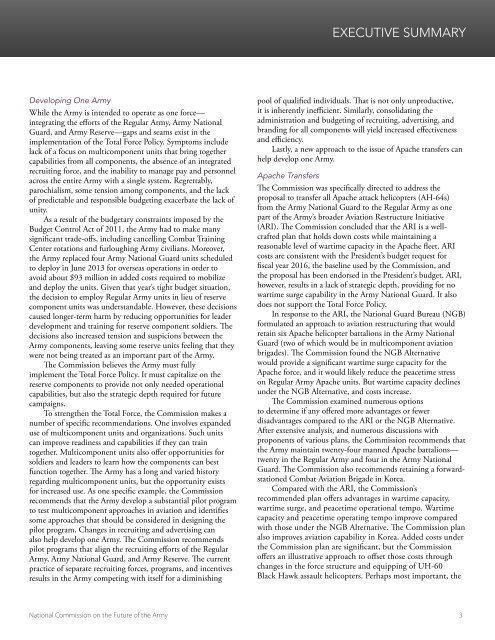THE FUTURE OF THE ARMY
Futurearmy
Futurearmy
You also want an ePaper? Increase the reach of your titles
YUMPU automatically turns print PDFs into web optimized ePapers that Google loves.
EXECUTIVE SUMMARY<br />
Developing One Army<br />
While the Army is intended to operate as one force—<br />
integrating the efforts of the Regular Army, Army National<br />
Guard, and Army Reserve—gaps and seams exist in the<br />
implementation of the Total Force Policy. Symptoms include<br />
lack of a focus on multicomponent units that bring together<br />
capabilities from all components, the absence of an integrated<br />
recruiting force, and the inability to manage pay and personnel<br />
across the entire Army with a single system. Regrettably,<br />
parochialism, some tension among components, and the lack<br />
of predictable and responsible budgeting exacerbate the lack of<br />
unity.<br />
As a result of the budgetary constraints imposed by the<br />
Budget Control Act of 2011, the Army had to make many<br />
significant trade-offs, including cancelling Combat Training<br />
Center rotations and furloughing Army civilians. Moreover,<br />
the Army replaced four Army National Guard units scheduled<br />
to deploy in June 2013 for overseas operations in order to<br />
avoid about $93 million in added costs required to mobilize<br />
and deploy the units. Given that year’s tight budget situation,<br />
the decision to employ Regular Army units in lieu of reserve<br />
component units was understandable. However, these decisions<br />
caused longer-term harm by reducing opportunities for leader<br />
development and training for reserve component soldiers. The<br />
decisions also increased tension and suspicions between the<br />
Army components, leaving some reserve units feeling that they<br />
were not being treated as an important part of the Army.<br />
The Commission believes the Army must fully<br />
implement the Total Force Policy. It must capitalize on the<br />
reserve components to provide not only needed operational<br />
capabilities, but also the strategic depth required for future<br />
campaigns.<br />
To strengthen the Total Force, the Commission makes a<br />
number of specific recommendations. One involves expanded<br />
use of multicomponent units and organizations. Such units<br />
can improve readiness and capabilities if they can train<br />
together. Multicomponent units also offer opportunities for<br />
soldiers and leaders to learn how the components can best<br />
function together. The Army has a long and varied history<br />
regarding multicomponent units, but the opportunity exists<br />
for increased use. As one specific example, the Commission<br />
recommends that the Army develop a substantial pilot program<br />
to test multicomponent approaches in aviation and identifies<br />
some approaches that should be considered in designing the<br />
pilot program. Changes in recruiting and advertising can<br />
also help develop one Army. The Commission recommends<br />
pilot programs that align the recruiting efforts of the Regular<br />
Army, Army National Guard, and Army Reserve. The current<br />
practice of separate recruiting forces, programs, and incentives<br />
results in the Army competing with itself for a diminishing<br />
pool of qualified individuals. That is not only unproductive,<br />
it is inherently inefficient. Similarly, consolidating the<br />
administration and budgeting of recruiting, advertising, and<br />
branding for all components will yield increased effectiveness<br />
and efficiency.<br />
Lastly, a new approach to the issue of Apache transfers can<br />
help develop one Army.<br />
Apache Transfers<br />
The Commission was specifically directed to address the<br />
proposal to transfer all Apache attack helicopters (AH-64s)<br />
from the Army National Guard to the Regular Army as one<br />
part of the Army’s broader Aviation Restructure Initiative<br />
(ARI). The Commission concluded that the ARI is a wellcrafted<br />
plan that holds down costs while maintaining a<br />
reasonable level of wartime capacity in the Apache fleet. ARI<br />
costs are consistent with the President’s budget request for<br />
fiscal year 2016, the baseline used by the Commission, and<br />
the proposal has been endorsed in the President’s budget. ARI,<br />
however, results in a lack of strategic depth, providing for no<br />
wartime surge capability in the Army National Guard. It also<br />
does not support the Total Force Policy.<br />
In response to the ARI, the National Guard Bureau (NGB)<br />
formulated an approach to aviation restructuring that would<br />
retain six Apache helicopter battalions in the Army National<br />
Guard (two of which would be in multicomponent aviation<br />
brigades). The Commission found the NGB Alternative<br />
would provide a significant wartime surge capacity for the<br />
Apache force, and it would likely reduce the peacetime stress<br />
on Regular Army Apache units. But wartime capacity declines<br />
under the NGB Alternative, and costs increase.<br />
The Commission examined numerous options<br />
to determine if any offered more advantages or fewer<br />
disadvantages compared to the ARI or the NGB Alternative.<br />
After extensive analysis, and numerous discussions with<br />
proponents of various plans, the Commission recommends that<br />
the Army maintain twenty-four manned Apache battalions—<br />
twenty in the Regular Army and four in the Army National<br />
Guard. The Commission also recommends retaining a forwardstationed<br />
Combat Aviation Brigade in Korea.<br />
Compared with the ARI, the Commission’s<br />
recommended plan offers advantages in wartime capacity,<br />
wartime surge, and peacetime operational tempo. Wartime<br />
capacity and peacetime operating tempo improve compared<br />
with those under the NGB Alternative. The Commission plan<br />
also improves aviation capability in Korea. Added costs under<br />
the Commission plan are significant, but the Commission<br />
offers an illustrative approach to offset those costs through<br />
changes in the force structure and equipping of UH-60<br />
Black Hawk assault helicopters. Perhaps most important, the<br />
National Commission on the Future of the Army 3


